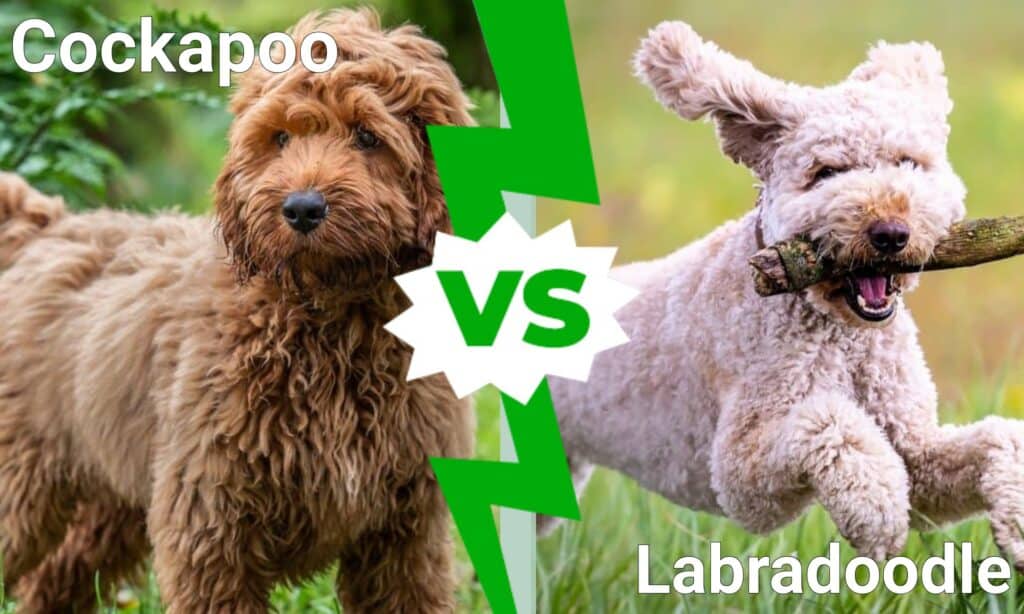While there are many different poodle crossbreeds, we’ll be discussing everything you need to know about the Cockapoo vs Labradoodle today. Both of these dogs have poodle DNA, but what else might they share with each other, and in what ways are they different? If you are interested in learning more about the Cockapoo and the Labradoodle, you’re in the right place!
In this article, we will go over everything you need to know about the Labradoodle and the Cockapoo, including the ways in which they are similar. We will address their physical appearances, including their size differences. Additionally, we will go over their behaviors and ancestries so that you can get the full scope of both of these breeds. Let’s get started!
Comparing Cockapoo vs Labradoodle

| Cockapoo | Labradoodle | |
|---|---|---|
| Size | 10-16 inches tall; 20-60 pounds | 22-24 inches tall; 50-60 pounds |
| Appearance | Small and slender, found in black, cream, brown, apricot, and red colors. Often has additional markings as well. Ears look similar to cocker spaniel ears, and the coat is silky, curly, and textured | Slender and graceful in the body, covered in wavy or curly fur. Found in an endless number of colors, with a friendly face. Often has a longer muzzle, but it depends on the amount of Labrador DNA present |
| Ancestry | Originally bred in the 1960s as a family dog and companion animal, but with a healthy hunting background. Cross between a poodle and an American cocker spaniel | Originally bred in the 1980s as a hypoallergenic guide dog solution for those allergic to Labrador or Golden Retrievers. Now, they are extremely popular family pets. Cross between a poodle and a Labrador Retriever |
| Behavior | Very playful and loves to swim given its ancestry; may be prone to separation anxiety and stubbornness due to their high intelligence | Highly adaptive and intuitive learners; ideal for guide dog work given their patience, compassion, and problem solving abilities. Require constant stimulation |
| Lifespan | 12-16 years | 10-12 years |
Key Differences Between Cockapoo vs Labradoodle

The Cockapoo is an older dog breed than the Labradoodle, though both are recent hybrid breeds.
©iStock.com/LSOphoto
There are many key differences between the Cockapoo and the Labradoodle. The Labradoodle grows larger than the average Cockapoo, in both height and weight. Additionally, the Cockapoo has longer ears compared to the average Labradoodle. The Cockapoo is an older dog breed than the Labradoodle, though both are recent hybrid breeds. Finally, the Labradoodle lives a slightly shorter lifespan compared to the lifespan of the Cockapoo.
Let’s discuss all of these differences in more detail now.
Cockapoo vs Labradoodle: Size

Most Labradoodles range in weight from 50 to 60 pounds, while the average Cockapoo begins at 20 pounds and may reach 60 pounds.
©Lee Ph/Shutterstock.com
While it depends on the DNA makeup of both of these dog breeds, the Labradoodle grows larger on average compared to the Cockapoo. This is likely due to the Labradoodle’s Labrador Retriever DNA, as Labradors are far larger than Cocker Spaniels, the dog that makes up the other half of a Cockapoo. But let’s take a closer look at the figures now.
Depending on gender, the average Labradoodle grows as tall as 22 to 24 inches, while the average Cockapoo reaches 10 to 16 inches tall. Additionally, most Labradoodles range in weight from 50 to 60 pounds, while the average Cockapoo begins at 20 pounds and may reach 60 pounds, though it is rare. Most Cockapoos are bred using miniature poodles rather than standard poodles, and Labradoodles are only bred using standard-size poodles.
Cockapoo vs Labradoodle: Appearance

Both of these dogs are found in a variety of colors, though the ears of the Cockapoo are frequently longer than the ears of the Labradoodle.
©iStock.com/Jennifer McCallum
It can be extremely difficult to tell the difference between a Labradoodle and a Cockapoo. This is because they are similarly bred with poodles, giving them textured fur that is soft and hypoallergenic. Both of these dogs are found in a variety of colors, though the ears of the Cockapoo are frequently longer than the ears of the Labradoodle.
Otherwise, it can be extremely difficult to tell them apart based on first glance, other than their obvious size differences. The body of the Labradoodle is more slender and elegant compared to the body of the Cockapoo, and the facial shapes of both of these dogs may differ from one another, depending on their DNA.
Cockapoo vs Labradoodle: Ancestry and Breeding

The Cockapoo was first bred in the 1960s, while the Labradoodle was first bred in the 1980s.
©Oliver_Jack/Shutterstock.com
You may have already guessed, but the ancestry and breeding of the Labradoodle differs greatly from that of the Cockapoo. Both of these dogs are a cross with poodles, though the Cockapoo is part Cocker Spaniel and the Labradoodle is part Labrador Retriever. In addition, the Cockapoo was first bred in the 1960s, while the Labradoodle was first bred in the 1980s.
While they were both bred with hypoallergenic qualities in mind, the Cockapoo was originally bred to be a healthy hunting dog that does well with families, and the Labradoodle was originally bred to be a hypoallergenic guide dog for those in need. Both of these breeds are highly sought after by a variety of people and families, given their average personalities. Let’s talk more about that now.
Cockapoo vs Labradoodle: Behavior

Given their background in guide dog work, Labradoodles enjoy mental stimulation and performing for humans more than the average Cockapoo does.
©Sophia Granchinho/Shutterstock.com
Both the Labradoodle and the Cockapoo work in a variety of families and household situations, though both of these dog breeds need plenty of exercise and attention. If left alone for long periods of time or otherwise ignored, both of these dog breeds can exhibit moments of separation anxiety and stress.
Given their background in guide dog work, Labradoodles enjoy mental stimulation and performing for humans more than the average Cockapoo does. In addition, the Cockapoo tends to be more stubborn than the average Labradoodle in training and behavioral situations. However, both of these intelligent dogs are highly capable and eager to learn!
Cockapoo vs Labradoodle: Lifespan

While both of these dogs live long and healthy lives with proper care, the average Cockapoo lives longer than the average Labradoodle.
©Kimberley Rennie/Shutterstock.com
The final difference between the labradoodle and the Cockapoo is their lifespans. While both of these dogs live long and healthy lives with proper care, the average Cockapoo lives longer than the average Labradoodle. This is likely due to their size differences, as large dogs live shorter lives than smaller dogs on average.
For example, the average Cockapoo lives anywhere from 12 to 16 years old, while the average Labradoodle only reaches 10 to 12 years on average. However, this always depends on the individual care and health of the dog itself, and always make sure that your dog gets plenty of exercise!
Are Labradoodles More Like Labs or Poodles?

Research has revealed that the
Australian Labradoodle
is actually more poodle than Labrador retriever.
©Jne Valokuvaus/Shutterstock.com
Labradoodles that are first-generation bred are known to be direct offspring of the labrador and the poodle. Additionally, there are two different types of labradoodles – the Australian labradoodle and the American Labradoodle which are then broken down into multi-generations, which can further dilute how much of one parent breed they may have.
Research, as well as genetic testing and analysis conducted, has revealed that the Australian Labradoodle is actually more poodle than Labrador retriever. The genomes of later generations of these crossbreeds are comprised of almost all poodle DNA, which has led some to state that they should actually be called a ‘poodledor’.
The photo featured at the top of this post is © KariDesign/Shutterstock.com
Ready to discover the top 10 cutest dog breeds in the entire world?
How about the fastest dogs, the largest dogs and those that are -- quite frankly -- just the kindest dogs on the planet? Each day, AZ Animals sends out lists just like this to our thousands of email subscribers. And the best part? It's FREE. Join today by entering your email below.
Thank you for reading! Have some feedback for us? Contact the AZ Animals editorial team.






